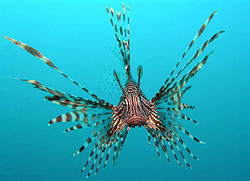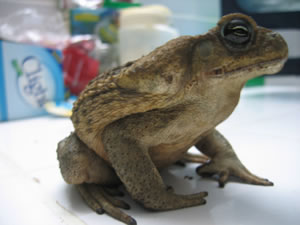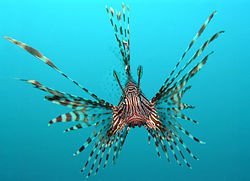Category Archives: Invasive species
“Killer” Shrimp Invading Wales: Discovered in Two Locations
A “killer” shrimp which makes meals out of young fish, insect larva, and the shrimp native to the area has been discovered at two different locations in Wales, comments the Environment Agency.
These sneaky little invaders, known in scientific circles as Dikerogammarus villosus, actually changes the ecology of the environments that it takes over, and can even cause mass die offs and extinctions.
The invader was discovered in the UK at reservoir in Cambridgeshire this past September.
Environment Agency Wales has commented that it has just confirmed the presence at Cardiff Bay and Eglwys Nunyd Reservoir in Port Talbot. It is still unknown as to how the interloper got there.
You see, this “killer” shrimp originally hails from a region between the Caspian Sea and the Black Sea, however it has spread over most of Western Europe across the last decade.
This sneaky invader can be as tiny as 3 millimeters, but can grow as large as 30 millimeters long, making it much bigger than the freshwater shrimp native to the area.
Biologists have dubbed this tiny invader a killer, as it mainly kills more than its fill, and leaves its meals largely uneaten.
This invader is really causing some alarm, and has led to the Welsh Assembly Government setting up an all-wales group to help and figure out how to contain problem, so that it doesn’t spread any further.
Environment Agency Wales director Chris Mills commented:
“We will continue with our monitoring work across Wales to identify any other water recreation spots where they could be to see how widespread the problem has become.”
Red Lionfish Being Caught in Keys: Over 650 Reeled In:
There are now 659 less Indo-Pacific red lionfish calling the tranquil waters of the Florida Keys National Marine Sanctuary home.
The end to a bunch of lionfish derbies was held this past Saturday off the lower keys. As you know, these lionfish have been making quite a nuisance of themselves for the past little while, and efforts have been made to get rid of the little rascals, whether it be simple catching, netting in, and even pan frying.
Diving teams managed to round up 109 of these dastardly invaders, adding to the tally of lionfish brought in froIndo-Pacific red lionfish m the previous derbies in Key Largo and Marathon.
Lionfish which are muscling their way into the waters off the southeast United States, Bahamas and Caribbean are causing harm to the native species to those waters as they are chowing down on vital reef species, such as snapper and grouper.
A spokesperson for the Reef Education Foundation, Lad Atkins, has commented that lionfish don’t have any natural enemies, except for us humans.
¨Hunters Becoming the Hunted: Lionfish Role Reversal!
The Ministry of Agriculture and Fisheries in Jamaica is taking some drastic measures to help prevent the collapse of the marine fisheries. They are now promoting lionfish as being a tasty treat for any menu. This effort is to help control the explosive growth of the lionfish population.
Officials have said that the nation’s marine biodiversity, its food security and economic well-being are all at risk.
“The situation in Jamaica is urgent,” commented the national coordinator for the Jamaican component of a Caribbean-wide Invasive Alien Species Project at the National Environment and Planning Agency, Nelsa English.
“A lack of sufficient natural predators suggests that it (lionfish) could be a potentially significant threat to Jamaica’s biodiversity and the ecosystem in general,” she added.
The marine resources of Jamaica are stretched dangerously thin, its reefs are being exploited to the point of extinction, and the fishing practices being used are detrimental to the environment. Some people even go as far as to use explosives to bring up their fish! Those that don’t often use toxic chemicals and nets whose mesh is illegally small.
Researchers have agreed that many of the once majestic reefs have been decimated to becoming mere communities of coral, and no longer operate as complete ecosystems due to the lack of diversity that calls them home.
Well seems to me that lionfish are part of the problem, and Jamaica has the answer. They are following suit as other nations are frying them up, putting them in sandwiches or using them as a pizza topping.
Cane Toads Wiping the Floor With Crocs!
Cane toads are killing off the freshwater crocodiles which make their home in the Victoria River District in Australia. The toads have been credited for the demise of hundreds of these crocs, and don’t show any sign of letting up any time soon.
A group of scientists have been studying the happenings of the Victoria River since 2005, to take a gander at how the toad is effecting the local wildlife.
The leader of the group, Dr. Mike Letnic, has recently returned from a scouting trip to the area.
“I haven’t put all of the figures together yet but when we look at the data from Victoria River Downs, where the cane toads came through in 2006, the crocodile populations are down as much as 80 per cent.
“We did test some crocodiles a few years ago, some of the survivors, but we found no evidence that they had any immunity.
“The other idea we had was that the crocodiles might learn to avoid toads and we found a little bit of evidence in the laboratory, that crocs will learn.
“But in the wild it seems to be a different story, we keep seeing crocodiles chomping on toads.”
Yes, you would think the crocs would learn, however, seems that when a croc goes to chomp a cane toad, none of the other crocs are watching… Seems to me the crocs need to come up with a defensive plan, and soon, before they are all wiped out.
Lionfish Now Invading Coastline of Alabama
Well, isn’t this just a kick in the pants… The invasive, not to mention sneaky, lionfish has been spotted off of Alabama and Pensacola this past week, which is confirming the belief that the lionfish have made a full scale invasion of the Gulf Of Mexico, despite the BP oil spill fiasco, and are now a danger to other sea faring critters in the area.
Researchers think the sneaky little buggers made their way into U.S. Waters because of the aquarium trade.
Scuba divers got together to try and capture these invading lionfish in the Florida Keys National Marine Sanctuary this past Saturday and over 500 of the suckers were reeled in.
In studies performed in the Bahamas, these tiny invaders have been eating up anywhere up to sixty percent of the fish native to the waters and coral reefs where they were making their home.
“I am surprised it took so long,” commented head of the Dauphin Island Sea Lab, George Crozier. “The way they’ve established themselves along the Atlantic, there really wasn’t any doubt they would arrive here… It was just a question of when.”
So, lionfish are apparently here to stay, and despite our rather inhospitable welcome, we are inviting them to our restaurant dinner plates as the main course, they appear to be flourishing where they should not be found in the first place.
Of course this pattern will continue to increase, and in the near future, perhaps they will be like the cockroaches of the sea, impossible to get rid of, and a huge pain in the backside.
More Than 500 Lionfish Caught by Divers in Keys Derby
You can forget about such trivialities as the amberjack or snapper. Over one hundred divers have managed to bring in more than five hundred Indo-Pacific red lionfish during the first group effort to help decrease the numbers of this wily invader which has set its sights on the Florida Keys National Marine Sanctuary.
The first of three such get togethers, cleverly dubbed lionfish derbies, brought in some twenty-seven teams which were all gun ho on earning the sweet cash and prizes being dangled in front of them to bring in the most, biggest, and mot tiny lionfish. The big enchilada, one thousand dollars, was given to the group which managed to snare in one hundred and eleven lionfish.
The next “derby” is shceduled to take place this coming October 16th, weather permitting, at Keys Fisheries restaurant in Marathon, and the final event is said to be November 13th at the Hurricane Hole Marina in Key West.
A representative of the Reef Environmental Education Foundation, Lad Akins, has commented that the lionfish are being released inadvertently by pet owners into the Atlantic, and since they have no natural enemies, they are free to breed and take over.
These lionfish have become quite an item, them being offered up in restaurants and such to help keep them down.. Only time will tell if we are winning the battle, or losing…
Invaders Feasting on Shrimp Native to British Waters!
Hide the fry, make sure they are tucked away good and tight. The boogie man of shrimp has come to town. This time it has selected Britain.
Britain appears to be under siege from a battalion of what appear to be killer shrimp.
This hungry invader, known as Dikerogammarus villosus, has been found by fishermen at Grafham Water in Cambridgeshire.
These shrimp, which are much larger than the shrimp native to Britain, come from Eastern Europe but have been steadily making their way westward, presumably looking for the buffet, for the past 10 years.
These invaders are aggressive hunters, and are feeding on the native freshwater shrimp, damselflies, small fish and water boatmen, and are poised to turn the local food chain on its head.
Often the shrimp kill just for the sport of it, and can rapidly take over lakes and rvers.
They aren’t a danger to local drinking water supplies, however fishermen have been warned to double check for the sneaky buggers so as to not aid in their spreading.
Researchers are taking the threat very seriously, and are now testing the water to see how widespread the problem is, and how to put a clamp on it.
Seems to me a lot of invasive species are making their ways into places they shouldn’t.. Global Warming? Or something more sinister? Either way, looks like Britain might be poised for a huge shrimp fry.
Madagascar Alarmed at Self-Cloning Crayfish Invasion
An invading rare kind of self-cloning crayfish has been discovered in Madagascar, and is causing all sorts of alarm among researchers. Scientists are afraid that if these self-cloning crayfish continue to expand their territory that it could have sever consequences on the local environment. Madagascar is the home of numerous plants and animals, and is very delicately balanced. These invading crayfish may cause quite a disturbance.
The fear is escalating on Madagascar, an island located on the Indian ocean, as this self-cloning crayfish are invading and are eating their fair share of the rice paddies, and are an imminent threat to the endemic crayfish species.
It is not quite clear just how, or when, these shrimp like crustaceans, which are believed to have come from North America, came to Madagascar, which is some 400 miles off the coast of Mozambique.
Researchers think that the crayfish may have made its way from Europe, where scientists from Germany warned that crayfish were becoming very prolific as aquarium fish back in 2003.
A biologist at the Universite d’Antananarivo, professor Olga Ramilijaona, has explained that the first of these crayfish were found in a rice paddy close to the Capital in 2003.
However, the first “invasion” of the species, known as Marmorkrebs or Procambarus due to the fact that they appear to be closely related to North American crayfish in the genus Procambarus, particularly Procambarus fallax, came in the rainy season of 2007, when the crayfish, which were sold to less fortunate locals as a source of protein in the diet, began being sold in the markets.
Looks like there will be plenty enough to go around on the menu, if something isn’t done about this soon.. Scientists still don’t have a plan of action, but they are working on it.
New Outlet to Report Your Sightings of Aliens
For our UK readers: Have you ever found a foreign species and ever wondered what could be done about the situation? Wonder no more! You can now do your bit to help out the environment in the UK by reporting your sightings of these creatures.
Defra has recently foot the bill for a web-based project which will allow you to share your contacts with foreign species, which are just not supposed to be there.
The project is being run by the National Biodiversity Network, Anglia Ruskin University, GB Non-native Species Secretariat and the Center for Ecology and Hydrology, and its primary focus will be on ten of the some odd 3,000 plus non-native species currently making their home in the UK.
These ten species you can report on the website were selected because they are easily identifiable, are highly invasive, and of course how useful the information is going to be once it is collected.
The ten species that made it to the “Most Wanted” list are: the Chinese mitten crab, Zebra mussel, American Bullfrog, Creeping water-primrose, Floating Pennywort, and Water Fern.
You can have learn more about the project, how you can get involved, and submit your report on the Recording Invasive Species Counts (RISC) Website.
Any of the reports you submit will be checked by experts; as such it is kindly requested that with each submission you do, that you also submit as much detailed information as possible, along with a photograph.
Once your report has been verified, it will be added to a national database and made available for public viewing on the National Biodiversity Network Gateway.
Asian Carp Made its Home In Great Lake Waters
This past June a bighead carp was reeled in near Lake Michigan, and it seems highly likely that it spent just about its entire life in the Great Lakes.
This whopper of a fish, weighing in at 9 kilograms, was reeled in in Lake Calumet on the 22nd of June this year. This was the first Asian carp which was reeled in on the wrong side of the electric barriers placed underwater strategically near Chicago to help prevent this invasive species from moving up the Mississippi River system and make its way into the Great Lakes.
Scientists at the Illinois Aquaculture Center, in conjunction with researchers at the Southern Illinois University Carbondale Fisheries, were analyzing the chemical markers in the inner ear bones of the carp and just released their results this past Thursday.
As fish mature, their bones take in the chemicals from their ambient surroundings, and will contain the unique chemical footprint of where the fish had made its home.
“It is very plausible that this fish originated in the Illinois River and then moved or was transported to Lake Calumet or Lake Michigan during the early portion of its life,” the Illinois Aquaculture center’s director, Jim Garvey commented during a session..
The assistant director of the Illinois Department of Natural Resources, John Rogner, has said that the results from the tests indicate that the fish may have been put into the Lake by humans.
It has been known that East Asian Buddhists sometimes let fish go as a practice of their religion.
For this reason, the sale of Asian carp has been banned in Ontario and many U.S. States, and their transporting them live across state lines is also prohibited.







